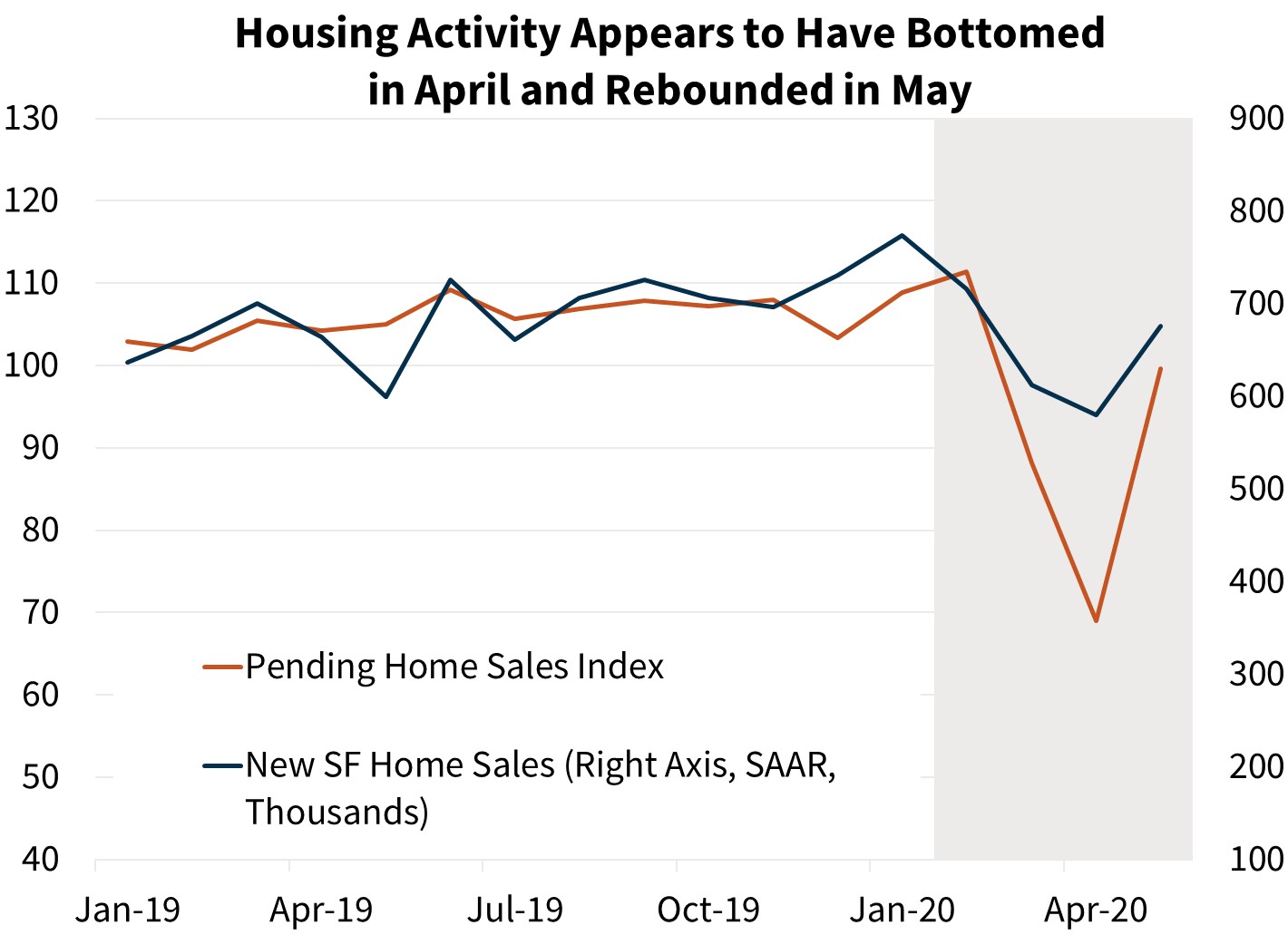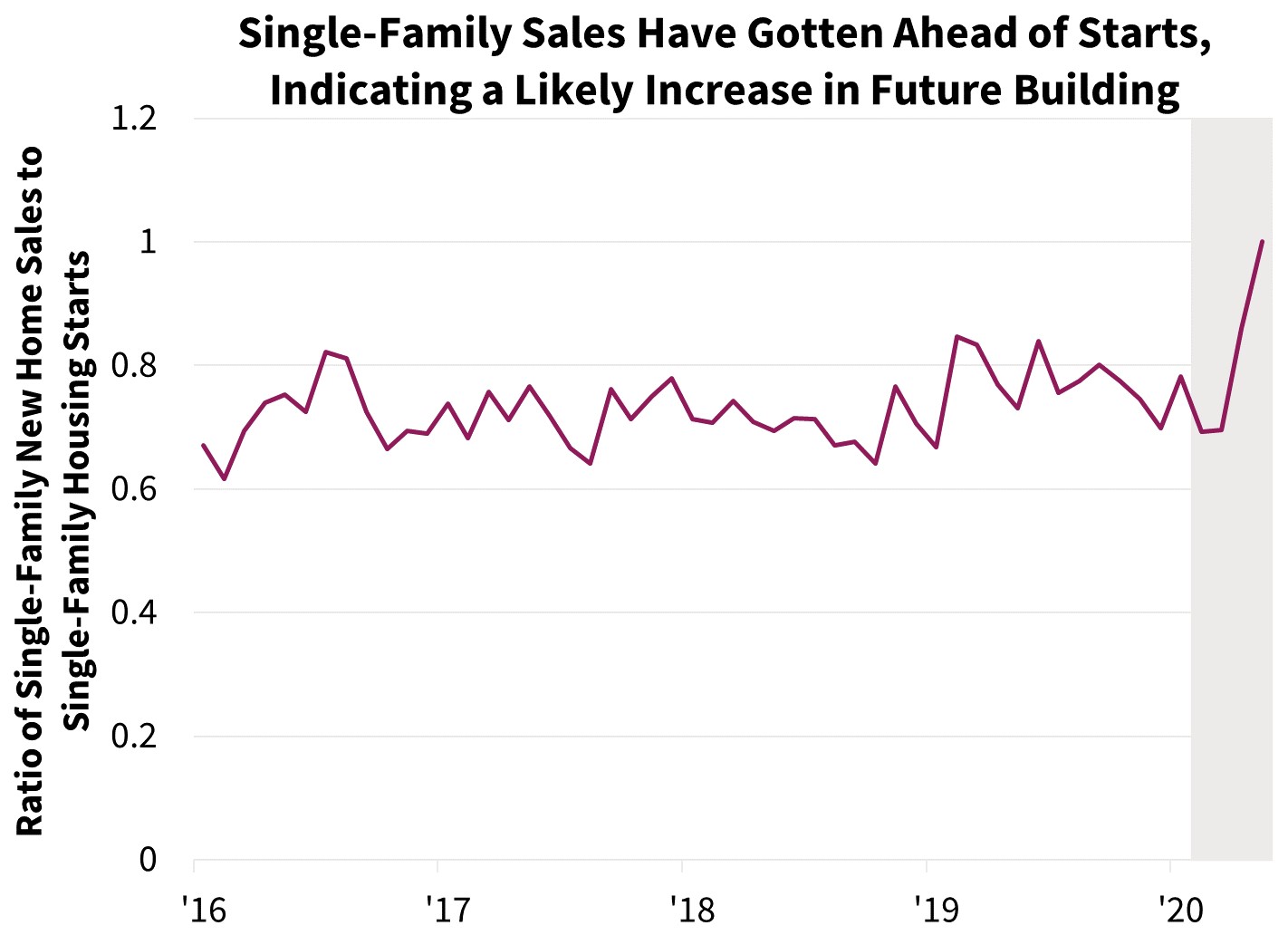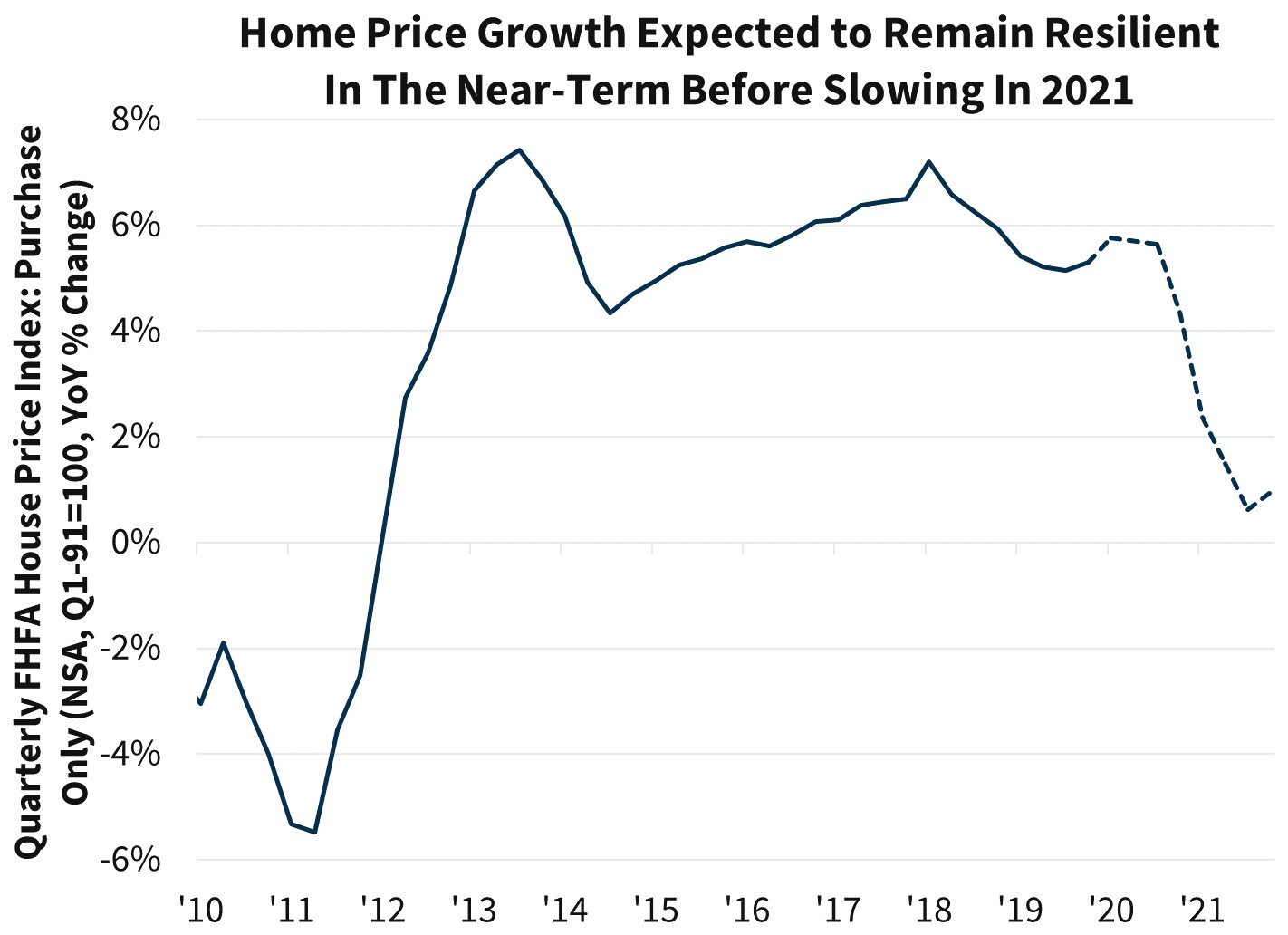Reopening of Economy Followed by a Partial Rebound in Growth - and in COVID-19 Cases
Our July gross domestic product (GDP) forecast for 2020 has been revised upward despite news of regional resurgences of COVID-19 cases. We now expect full-year 2020 GDP to decline 4.2 percent compared to our previous forecast of a 5.4 percent decline. This improvement is almost entirely due to a stronger pace of recovery to date than we had previously expected. We believe the resurgence in coronavirus cases will drag on growth going forward, but we assume that any future shutdowns and personal behavioral changes will be less severe than what occurred earlier this year and will be more localized than national in scope. Furthermore, given that consumer spending has yet to fully rebound, we expect future behavioral responses will likely translate into only a drag on growth rather than a sharp decline, as occurred in the early spring.
We had previously expected a consumer recovery to begin in May, but incoming spending data for the month was stronger than anticipated, and various high frequency data measures suggest continued momentum into June. This led to a significant upward revision in Q2 personal consumption expenditures (PCE). Our topline GDP forecast for Q2, however, was only slightly changed from a 37.0 percent annualized decline last month to a 34.8 percent drop due to stronger PCE growth partially counteracted by an updated expectation for a larger drawdown in business inventories. The combination of a higher consumption expenditure starting point and a comparatively lower need to draw down inventories in Q3 translates into a higher expected quarterly rate of growth for Q3, which we now expect will be 27.4 percent annualized, 7.9 percentage points higher than we had previously forecast. Looking beyond the third quarter and into 2021, expectations for growth have been pared back, in part due to the resurgence of coronavirus cases. Our anticipated recovery path remains shaped like a "swoosh," and we believe the current economy is likely transitioning from a phase of rapid recovery to a more modest path of growth.

The risks to our forecast are largely balanced and revolve around the coronavirus pandemic. To the downside, the regional resurgence in cases is concerning. To date, the pace of hospitalizations has not matched the resurgence in measured cases, but if hospitals become overloaded there may be significant regional shutdowns as well as mandated or self-imposed quarantines by consumers and businesses. To the upside, if this wave of infections does not translate into heightened levels of severe cases, then consumer spending may be more resilient than currently forecast. Localized shutdowns would remain modest compared to the previously experienced shutdowns across the country.
Uncertainty also remains regarding the extension of unemployment benefits or the passage of another stimulus package. In the short run, additional stimulus would be supportive of consumer and business spending, but if no extension occurs, a decline in consumer spending later in the summer is possible.
Recent home purchase measures have continued to show remarkable strength, leading us to revise upward our home sales forecast, particularly over the third quarter. Similarly, we bumped up our expectations for home price growth and purchase mortgage originations. Incoming construction spending data led us to refine the current relationship between future construction spending and the recent pace of housing starts, which resulted in a revision to our residential fixed investment (RFI) forecast. We now expect considerably stronger RFI growth in the third quarter followed by a pullback in late 2020.
Consumer Recovery Began in May
Most recent economic data have indicated a solid rebound in May and June as the economy began reopening in earnest. Real PCE jumped 8.1 percent in May, somewhat stronger than we had anticipated. Nearly all subcomponents of consumption saw growth, with a particularly sharp rebound in healthcare spending, as previously delayed procedures from March and April were pushed to May. In June, light vehicle sales rose for the second straight month, increasing to 13.2 million annualized units. While this is still far below the 17.1 million-unit pace seen in February, consumers spending on big ticket items such as cars is a positive for the overall economy. In addition, various high frequency measures that we track also suggest a continued consumer recovery in June.
Households have been financially bolstered by enhanced unemployment insurance as well as stimulus checks. The personal savings rate remained historically high in May at 23.2 percent, providing support for further near-term consumer spending growth. Consumers also appear somewhat optimistic that the slowdown is comparatively temporary. Consumer confidence in June jumped 12.2 points, the largest increase since 2011, though well below early 2020 highs. While consumers' confidence in the present situation increased more than consumer expectations over the month, as a level, consumers are much more optimistic about the outlook six months from now.
While unemployment remained high, June was the second straight month of increasing job numbers, as many employees returned to work after the shutdowns. Nonfarm payroll employment jumped by 4.8 million with over half of this gain in the leisure/hospitality and retail trade sectors. Though it remains 7.6 percentage points above the February level, the unemployment rate fell over 2 percentage points to 11.1 percent. We believe April was the peak for unemployment and expect the unemployment rate to continue to trend downward, ending the year around 8.4 percent. However, there may be volatility between months due to regional shutdowns or fluctuations in labor force participation resulting from unemployment benefit dynamics. A more timely indicator, initial unemployment insurance claims, has fallen significantly from its late-March peak, though this indicator still remains elevated compared to pre-coronavirus levels.
According to the Institute of Supply Management (ISM), both manufacturing and service sector activity increased in June to expansion territory for the first time in four and three months, respectively. Additionally, factory orders, a forward-looking indicator, increased in May for both durable and nondurable goods after plummeting for both series in March and April. This resurgence in activity highlights the impact of reopening businesses on the broader economy. This trend will have to be watched closely moving forward as some states and cities have been forced to slow or reverse the current pace of reopening.
The Federal Reserve continued to provide support for financial markets and the economy through its asset purchases. At its June meeting, the Fed imposed an $80 billion floor on Treasury purchases and a $40 billion floor on mortgage-backed security purchases per month. Subsequently, the Fed balance sheet reached $7.1 trillion by mid-June, up from $4.2 trillion in early March. Then, for the first time since May 2019, the Fed balance sheet contracted for four straight weeks, ending the week of July 8 back near $6.9 trillion. This decline was driven by the balance of outstanding repurchase agreements (repos), which fell to zero that week. It was the first time in ten months that this key source of short-term funding was untapped by banks and indicates a continued stabilization of financial markets.
Magnitude of Housing Rebound Unexpectedly Strong
May housing data pointed to a strong recovery after April's lows, and more recent signs suggest further improvement in June and July. While existing home sales fell sharply for the third consecutive month, due to the time lag between contract signings and closings (when existing sales are measured), May's sales represent purchase contracts from March and April. Total existing sales fell 9.7 percent over the month to 3.9 million annualized units. We believe this large decline will likely represent the monthly near-term trough in sales. Pending sales, which measure contract signings, jumped 44.3 percent in May, indicating that closings will likely be much stronger in June and early July. Furthermore, according to the Mortgage Bankers Association, applications for purchase mortgages continued to surge in June, rising 20.8 percent for the month, also suggesting sales strength into July. While purchase applications data have shown signs of stabilization over the past few weeks, for the month of June they were up 16.7 percent from 2019 levels.
We had expected a rebound in purchase activity to occur in May and June as shutdown measures began to be relaxed, but the magnitude to date has been remarkably strong. It is likely that many homebuyers who would have purchased a home in March or April have instead done so in more recent months. Additionally, some purchases may have been pulled forward due to low mortgage rates and continued social distancing measures leading to some households reassessing their current living arrangements. Therefore, we modestly revised upward our forecast for Q2 existing home sales to 4.3 million annualized units from 4.1 million and increased our forecast for Q3 sales to 5.4 million annualized units from 4.9 million.

While recent activity has impressed, we continue to expect a pullback in existing sales over the latter half of the summer. Pent-up demand from the depressed spring homebuying season should wane. Additionally, the supply of homes available for sale continues to lag the pace of purchase activity. While listings are edging upwards, total homes available for sale in June remained 27.4 percent below inventories from a year prior according to Realtor.com. The current pace of sales is therefore not sustainable at the current rate of listings. We expect the monthly pace of existing sales to peak in July or August, followed by a pullback for the remainder of the year. We expect full-year 2020 existing sales to fall around 7.5 percent compared with 2019 before picking up to a steady pace of growth of 4.0 percent in 2021 as the economy continues to recover.

New home sales, which are recorded at the point of contract signing, posted an increase in May, rising 16.6 percent. This was largely in line with our expectations, but due to revisions to earlier data, the level was somewhat lower than forecast. New home sales held up fairly well in the early spring compared to existing home sales. At its low point in April, new single-family sales were down 15.6 percent from a year prior compared to existing single-family sales, which were down 24.8 percent. Homebuilders offered significant discounting in March and April to move inventory and were likely less concerned with infection risks in the same way a homeowner might be in listing an existing home. Weakness in existing home sales were therefore partially made up for by new home sales.
This stronger pace of new home sales in recent months has outpaced the trend in new construction. New single-family housing starts were essentially unchanged in May and the ratio of new single-family sales to the pace of new starts sat at the highest level since 2009. For new home sales to continue at the recent level, the pace of new construction would have to increase. Construction will likely increase in coming months, as permits for new single-family construction rose 12 percent in May, but it will take some time for a rebalancing to occur. While the employment of residential construction workers rose 3 percent in June, the employment level remained 5 percent below its peak in February. Tighter credit standards on construction and development loans is also expected to limit the pace of new construction going forward. We forecast new home sales to level out in coming months as the pace of starts accelerates into the remainder of the year, bringing the relationship back into balance.

Recent strength in sales corresponds with a view of stronger near-term house price growth. Home prices, as measured by CoreLogic, were up 4.8 percent year over year in June, the fastest pace of growth since November 2018. Combined in part with incoming data, we revised upward our forecast for 2020 annual home price growth, as measured by the FHFA index, to 4.4 percent compared to the previous forecast of 0.4 percent. However, strong price appreciation in the short run is expected to be partially offset later, as house price appreciation slows meaningfully moving into 2021, consistent with continued expected elevated unemployment rates over this period.
Multifamily construction rebounded partially in May as starts rose 15 percent to 299,000 annualized units. We had expected a modest decline; however, this series is particularly volatile and subject to large revisions. Still, combined with upward revisions to April's figure, our forecast for Q2 multifamily starts was revised upward to 285,000 units. Going forward, we continue to forecast a comparatively weak recovery in multifamily construction relative to single-family. We now expect multifamily starts in 2020 to be 352,000, an annual decline of 12.5 percent.
For more on multifamily market conditions please see the July 2020 Multifamily Market Commentary.
It should be noted that aside from risks to the forecast due to uncertainty over the course of the COVID-19 pandemic and the pace of the economic recovery, there are additional risks in assessing future homebuyer behavior. For now, we assume that recent purchase activity strength is largely driven by low mortgage rates and a reshuffling of sales due to the earlier shutdowns. However, it is possible that a major consumer preference change is underway, which could lead to a heightened level of home sales going forward. As remote working arrangements become more common, commuting distance may become less relevant to homebuyers, which could lead to a significant movement of households out of high-cost metros and central business districts. More generally, if there is a broad reassessment of desired housing features and amenities, home sales may remain elevated for quite some time relative to what macroeconomic conditions and mortgage rates might suggest. In addition, new single-family home construction spending, as well as remodeling expenditures, would likely be higher relative to our baseline forecast, while multifamily housing could experience weakened demand. Home price growth may also vary greatly across local geographic levels and housing types, as the readjustment process occurs. As attitudinal and market data becomes available, we expect to more explicitly take such preference shifts into account in the housing forecast; currently, they are a source of uncertainty.
Purchase and Refinance Volumes Revised Even Higher
Treasury yields moved mostly sideways in Q2, remaining close to or reaching historic lows. However, mortgage rates fell more sharply, compressing the spread between the 10-year Treasury and mortgage rates. The spread had previously widened sharply during Q1. It averaged 265 basis points in April, before falling to 243 basis points in June. Despite this decline, it was still significantly higher than 2019's average of 180 basis points. Therefore, there is potentially further room for the spread to contract as lender capacity constraints ease. We expect mortgage rates to fall below 3.0 percent by the end of this year, which should continue to provide support for home purchase activity.
Our forecast for purchase originations was upgraded consistent with the revisions to our home sales and house price forecast. We now expect purchase volumes to total $1.26 trillion in 2020, about $40 billion higher than last month's forecast, though this is still significantly lower than 2019 volumes. We expect purchase volumes will then grow by around 1.7 percent in 2021, as the broader economy continues to improve.
Additionally, we upgraded our forecast for refinance originations this month to nearly $1.9 trillion for 2020, a 5.5 percent increase from last month's forecast, based on stronger-than-expected acquisition, securitization, and application activity. We left our forecast for 2021 volumes essentially unchanged from last month. According to Freddie Mac, the 30-year fixed rate fell to 3.03 percent in the second week of July, a new all-time low, and we expect this current low-rate environment to continue to provide momentum for refinance demand in the short term. At the current mortgage rate, we estimate that nearly 60 percent of all outstanding loan balances have at least a half-percentage point incentive to refinance.
Economic & Strategic Research (ESR) Group
July 10, 2020
For a snapshot of macroeconomic and housing data between the monthly forecasts, please read ESR's Economic and Housing Weekly Notes.
Data source for charts: John Hopkins University CSSE, The COVID Tracking Project, National Association of REALTORS®, Census Bureau, Federal Housing Finance Agency, Fannie Mae ESR Group.
Opinions, analyses, estimates, forecasts and other views of Fannie Mae's Economic & Strategic Research (ESR) Group included in these materials should not be construed as indicating Fannie Mae's business prospects or expected results, are based on a number of assumptions, and are subject to change without notice. How this information affects Fannie Mae will depend on many factors. Although the ESR group bases its opinions, analyses, estimates, forecasts and other views on information it considers reliable, it does not guarantee that the information provided in these materials is accurate, current or suitable for any particular purpose. Changes in the assumptions or the information underlying these views, including assumptions about the duration and magnitude of shutdowns and social distancing, could produce materially different results. The analyses, opinions, estimates, forecasts and other views published by the ESR group represent the views of that group as of the date indicated and do not necessarily represent the views of Fannie Mae or its management.
ESR Macroeconomic Forecast Team
- Doug Duncan, SVP and Chief Economist
- Eric Brescia, Economist
- Rebecca Meeker, Financial Economist
- Mark Palim, VP and Deputy Chief Economist
- Nick Embrey, Economist
- Richard Goyette, Business Analyst
